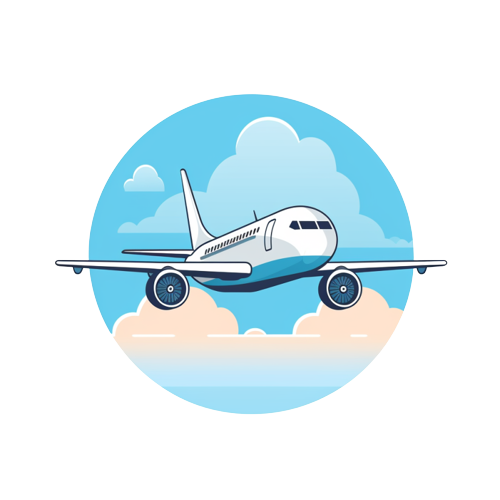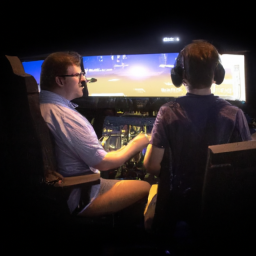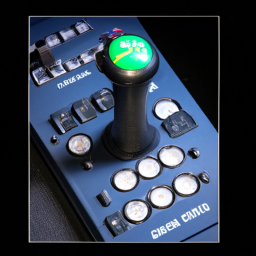In this article, you will discover whether there are flight simulators that offer multiplayer or co-pilot experiences. We will explore the options available and discuss the benefits of these features. By the end, you will have a better understanding of how to enhance your flight simulation experience by sharing it with others.
Introduction
Flight simulation has long been a popular pastime for aviation enthusiasts and aspiring pilots. Whether you dream of soaring through the skies or simply want to experience the thrill of piloting an aircraft, flight simulators provide a realistic and immersive virtual environment to fulfill your aviation fantasies.
One of the most intriguing aspects of flight simulation is the ability to connect with others and participate in multiplayer or co-pilot experiences. In this article, we will explore the types of flight simulators that offer these features, the benefits they provide, and the future developments in this exciting field.
Overview of Flight Simulators
Definition of flight simulators
Flight simulators are sophisticated computer programs that replicate the flight experience of aircraft. They simulate various aspects of flying, including the aircraft’s controls, systems, and physics. These virtual environments enable users to practice flying, learn about aviation concepts, and even enjoy simulated flights.
Purpose of flight simulators
Flight simulators serve several purposes. They are used for pilot training, as they offer a safe and cost-effective alternative to real aircraft for practicing flight procedures, emergency scenarios, and general flight maneuvers. They are also utilized for research and development purposes in the aviation industry to test aircraft performance and evaluate new technologies.
Evolution of flight simulators
Flight simulators have come a long way since their humble beginnings. Early flight simulators were rudimentary and lacked realism, but technological advancements have made them increasingly sophisticated and true to life. Today, flight simulators incorporate high-definition graphics, accurate physics models, and even motion platforms to provide an immersive and authentic flight experience.
Types of Flight Simulators
Full-motion flight simulators
Full-motion flight simulators, also known as Level D simulators, are the most realistic and expensive type of flight simulator. These simulators feature a physical cockpit that replicates the controls and layout of a specific aircraft type. They are mounted on a motion platform that can simulate the sensations of acceleration, turbulence, and even landing impacts. Full-motion simulators are mainly used for advanced pilot training and airline certification.
Desktop flight simulators
Desktop flight simulators, also called PC-based simulators, are the most accessible type of flight simulator. They run on personal computers, allowing users to experience flying from the comfort of their homes. These simulators typically feature realistic aircraft models, accurate physics, and customizable controls. They are popular among aviation enthusiasts, aspiring pilots, and gamers who enjoy the challenge of flying virtual aircraft.
Virtual reality flight simulators
Virtual reality (VR) flight simulators are the latest frontier in flight simulation technology. These simulators utilize VR headsets to provide an immersive and highly realistic flight experience. By wearing a VR headset, users can look around the virtual cockpit, interact with controls, and even feel a sense of depth and scale. VR flight simulators offer a level of immersion that is unparalleled by other types of simulators, making them a favorite among aviation enthusiasts.
Importance of Multiplayer and Co-pilot Experiences
Enhanced realism and immersion
Multiplayer and co-pilot experiences greatly enhance the realism and immersion of flight simulators. With multiplayer functionality, users can connect and fly together in the same virtual environment. They can communicate through voice chat, coordinate flights, and even form virtual airlines. Co-pilot experiences allow two users to fly together, with one acting as the pilot and the other as a co-pilot. This level of interaction and collaboration brings the virtual aviation world to life, making the experience even more authentic.
Collaborative learning and training
Multiplayer and co-pilot experiences also facilitate collaborative learning and training. Users can share their knowledge and experiences, learn from each other, and practice teamwork and communication skills. This is especially beneficial for aspiring pilots who can learn from more experienced virtual aviators. It also provides a platform for pilots to practice real-world flight procedures, such as communication with air traffic control and navigating complex airspace.
Social interaction and competition
Flight simulators with multiplayer capabilities offer a platform for social interaction and competition. Users can join online communities, participate in virtual air shows, and even compete in races and challenges. This fosters a sense of community and camaraderie among virtual aviators, allowing them to connect with like-minded individuals from around the world. The competitive aspect of multiplayer flight simulators adds excitement and motivation to the flying experience.
Flight Simulators with Multiplayer Capabilities
Leading flight simulators with multiplayer features
Several flight simulators offer multiplayer capabilities, allowing users to connect and fly together. One of the most popular simulators in this regard is Microsoft Flight Simulator, which features an expansive multiplayer mode that allows users to join sessions with others and explore the virtual world together. Another notable simulator is X-Plane, which also offers multiplayer functionality and a dedicated online community.
Benefits of multiplayer in flight simulators
Multiplayer functionality in flight simulators brings a host of benefits. It allows users to connect with friends or meet new people who share their aviation interests. Users can learn from each other, seek advice, and collaborate on virtual flights. Multiplayer also adds an element of realism, as users can observe other aircraft in the virtual airspace, communicate with them, and even participate in air traffic control interactions. Overall, multiplayer enhances the social and interactive aspects of flight simulation.
Challenges and limitations of multiplayer functionality
Despite its benefits, multiplayer functionality in flight simulators also comes with challenges and limitations. The sheer number of participants in multiplayer sessions can sometimes strain the simulator’s performance, leading to reduced frame rates and lag. Additionally, coordinating activities with other users can be challenging, as different users may have different flight objectives and schedules. Spaces within multiplayer sessions can also become crowded, making it difficult to find a suitable environment for specific flying experiences.
Co-pilot Experiences in Flight Simulators
Simulators with co-pilot functionality
While multiplayer allows for collaborative flight experiences, some simulators specifically cater to co-pilot experiences. These simulators enable users to fly together in a pilot-co-pilot relationship, with one user assuming the role of the pilot and the other as the co-pilot. This arrangement allows users to share the workload, communicate about flight procedures, and learn from each other. These simulators often emphasize the training aspect of flying, making them popular choices for aviation students and virtual flight schools.
Benefits of co-pilot experiences
Co-pilot experiences in flight simulators offer several advantages. They allow users to develop their teamwork and communication skills, which are essential in real-world aviation. Co-pilot experiences also make learning and training more engaging, as users can receive hands-on instruction and immediate feedback from their co-pilot counterparts. Additionally, having a co-pilot can provide an extra level of safety and support, especially when practicing complex flight maneuvers or emergency procedures.
Limitations of co-pilot features
Co-pilot experiences in flight simulators have their limitations. The effectiveness of the co-pilot functionality depends largely on the user’s ability to communicate and coordinate with their co-pilot counterpart. It can be challenging to find a reliable and knowledgeable co-pilot, especially in online multiplayer environments. Furthermore, the level of sophistication in co-pilot features varies among simulators, with some providing more realistic and interactive co-pilot interactions than others.
Community and Online Platforms
Online communities for flight simulator enthusiasts
Flight simulator enthusiasts have access to a myriad of online communities where they can connect, share experiences, and seek advice. These communities often have dedicated forums, social media groups, and Discord channels where users can interact with fellow aviation enthusiasts. Joining these communities allows users to stay updated on the latest simulator developments, discover new add-ons and modifications, and participate in organized events and competitions.
Platforms for multiplayer and co-pilot experiences
Many flight simulators utilize dedicated platforms to facilitate multiplayer and co-pilot experiences. These platforms serve as virtual meeting places, allowing users to connect with others, arrange flights, and communicate during flights. Some simulators have their own built-in platforms, while others utilize external services such as VATSIM or PilotEdge. These platforms often provide controllers for air traffic control, ensuring a realistic and organized online environment.
User-generated content and modifications
Flight simulators also offer extensive opportunities for user-generated content and modifications. Users can create and share their aircraft models, scenery, and flight plans, enriching the virtual aviation experience. This vibrant modding community allows users to enhance their simulators with third-party add-ons that provide additional aircraft, liveries, airports, and other features. These modifications further extend the multiplayer and co-pilot capabilities of flight simulators, enabling users to share and enjoy customized flying experiences.
Simulation Airlines and Organizations
Virtual airlines for multiplayer experiences
Virtual airlines are online organizations that simulate the operations of real-world airlines within flight simulators. These organizations offer multiplayer experiences by providing structured flights, flight schedules, and training programs. Users can join virtual airlines and fly together, following real-world flight procedures and regulations. Virtual airlines often have their own websites, forums, and dedicated servers, serving as hubs for virtual aviation enthusiasts.
Partnerships with flight training organizations
Flight simulators that offer multiplayer or co-pilot experiences often establish partnerships with real-world flight training organizations. These partnerships allow aspiring pilots to practice flight procedures and gain hands-on experience in a simulated environment. Flight schools may integrate flight simulators into their training programs, providing valuable opportunities for their students to learn and practice. This collaboration between the simulation and aviation industries helps bridge the gap between virtual and real-world flying.
Events and competitions
Flight simulators with multiplayer capabilities frequently host events and competitions that bring the community together. These events can range from airshows and fly-ins to air races and formation flying challenges. Organizers set up specific flight scenarios and objectives, encouraging users to demonstrate their piloting skills and creativity. Participating in these events gives users a chance to showcase their abilities, receive recognition, and foster a sense of friendly competition among virtual aviators.
Future Developments in Multiplayer and Co-pilot Experiences
Advancements in virtual reality integration
Virtual reality is expected to play an increasingly significant role in multiplayer and co-pilot experiences. As VR technology improves, flight simulators will offer even more immersive and realistic virtual environments. Users will be able to interact with other virtual aviators and perform complex flight maneuvers with unparalleled precision. The integration of hand tracking and other advanced VR features will further enhance the level of immersion and realism in multiplayer and co-pilot experiences.
Improved networking and connectivity
The advancement of networking and connectivity technology will also contribute to the progression of multiplayer and co-pilot experiences. Faster internet speeds and more efficient data transmission protocols will enable smoother and more seamless interactions between users. This will reduce lag and latency issues, resulting in a more enjoyable and realistic multiplayer environment. Improved networking capabilities will also allow for larger and more populated multiplayer sessions, creating a truly bustling and dynamic virtual airspace.
Potential for cross-platform compatibility
In the future, flight simulators may become cross-platform compatible, allowing users on different devices and operating systems to connect and fly together. This would transcend the limitations of specific simulator platforms and expand the multiplayer and co-pilot potential of flight simulators. Cross-platform compatibility would enable users to connect and collaborate regardless of their chosen simulator or hardware setup, fostering a more inclusive and diverse virtual aviation community.
Conclusion
Flight simulators that allow for multiplayer or co-pilot experiences offer an exciting and immersive world of virtual aviation. Whether you wish to collaborate with others in the virtual skies, compete with fellow aviators, or embark on a thrilling co-pilot journey, these simulators provide a platform for learning, social interaction, and skill development. As technology continues to advance, multiplayer and co-pilot experiences will only become more sophisticated and accessible, bringing the joy of aviation to an even wider audience. So, grab your flight controls and prepare for an unforgettable adventure in the captivating world of flight simulation.




